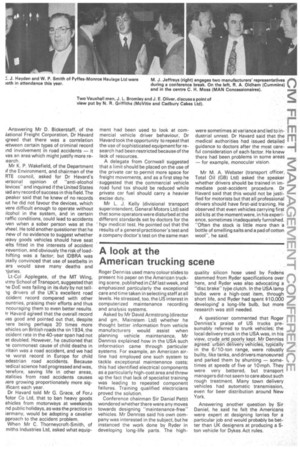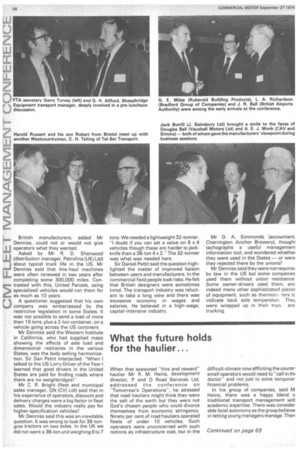A look at the American trucking scene
Page 67

Page 68

If you've noticed an error in this article please click here to report it so we can fix it.
Roger Denniss used many colour slides to present his paper on the American trucking scene, published in CM last week, and emphasized particularly the exceptional care and time taken in selecting staff at all levels. He stressed, too, the US interest in computerized maintenance recording and analysis systems.
Asked by Mr David Armstrong (director and gm, Mainstem Ltd) whether he thought better information from vehicle manufacturers would assist when planning vehicle maintenance, Mr Denniss explained how in the USA such information came through particular systems. For example, an American airline had employed one such system to tackle exceptional maintenance costs; this had identified electrical components as a particularly high-cost area and threw up the fact that lack of specialist training was leading to repeated component failures. Training qualified electricians proved the solution.
Conference chairman Sir Daniel Pettit wondered whether there were any moves towards designing "maintenance-free". vehicles. Mr Denniss said his own company was interested in the subject, but he instanced the work done by Ryder in developing long-life parts. The high
quality silicon hose used by Fodens stemmed from Ryder specifications over here, and Ryder was also advocating a "disc brake" type clutch. In the USA lamp bulbs were a high-cost item, through short life, and Ryder had spent $10,000 developinT a long-life bulb, but more research was still needed.
A questioner commented that Roger Denniss's praise of US trucks presumably referred to trunk vehicles; the local delivery truck in the USA was, in his view, crude and poorly kept. Mr Denniss agreed: urban-delivery vehicles, typically in the 6/10-ton range, were robustly builty, like tanks, and drivers manoeuvred and parked them by shunting — sometimes at speeds of five or 10 mph. They were very battered, but transport managers did not seem to care about such rough treatment. Many town delivery vehicles had automatic transmission, even for beer distribution around New York.
Answering another question by Sir Daniel, he . said he felt the Americans were expert at designing lorries for a particular job and would probably be better than UK designers at producing a 5ton vehicle for Dykes Act rules.
farm British manufacturers, added Mr Denniss, could not or would not give joperators what they wanted.
Asked by Mr R. D. Sherwood
jj (distribution manager, Petrofina (UK) Ltd) ovalabout typical truck life in the US, Mr Denniss said that line-haul machines u.„ were often renewed in two years after
completing some 300,000 miles. Contrasted with this, United Parcels, using specialized vehicles would run them for as much as 10 years.
A questioner suggested that his own
kati company was embarrassed by the restrictive legislation in some States. It was not possible to send a load of more than 16 tons, plus a 2-ton container, on a vehicle going across the US continent.
Mr Denniss said the Western Institute in California, who had supplied maps showing the effects of axle load and dimensional restraints in the various States, was the body selling harmonization. Sir Dan Pettit interjected: "When I talked to the US Lorry Driver of the Year I learned that good drivers in the United States are paid for finding roads where there are no weighbridges!"
Mr C. R. Bright (fleet and municipal sales manager, GN (CV) Ltd) said that in his experience of operators, discount and delivery charges were a big factor in fleet sales. Would the industry really pay for higher-specification vehicles?
Mr Denniss said this was an inevitable question. It was wrong to look for 38-tongcw tractors on two axles. In the UK we did not want a 38-ton unit weighing 6 to 7
tons. We needed a lightweight 32-tonner. "I doubt if you can set a value on 6 x 4 vehicles though these are harder to jackknife than a 38-ton 4 x 2." The 32-tormer was what was needed here.
Sir Daniel Pettit said the question highlighted the matter of improved liaison between users and manufacturers. In the commercial field people took risks. He felt that British designers were sometimes timid. The transport industry was reluctant to take a long view and there was excessive economy in wages and salaries. He believed in a high-wage, capital-intensive industry.
Mr D. A. Simmonds (accountant, Charrington Anchor Brewery), though) tachographs a useful managemeni information tool, and wondered whethei they were used in the States — or were they rejected there by the unions?
Mr Denniss said they were not requirec by law in the US but some companies used them without union resistance Some owner-drivers used them, anc indeed many other sophisticated pieces of equipment, such as thermoni ters tc indicate back axle temperature They were wrapped up in their qua anc trucking.




























































































































































